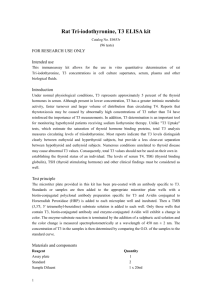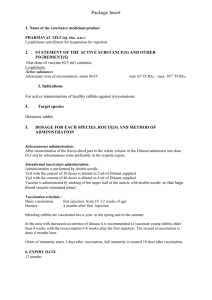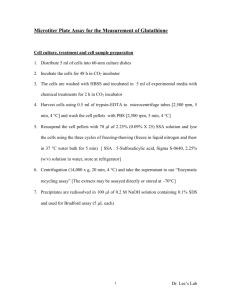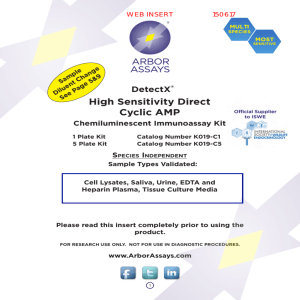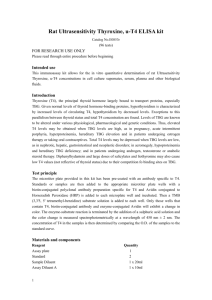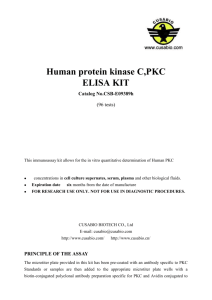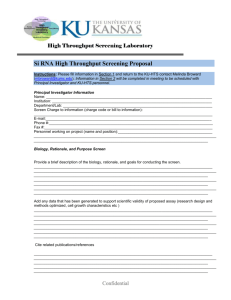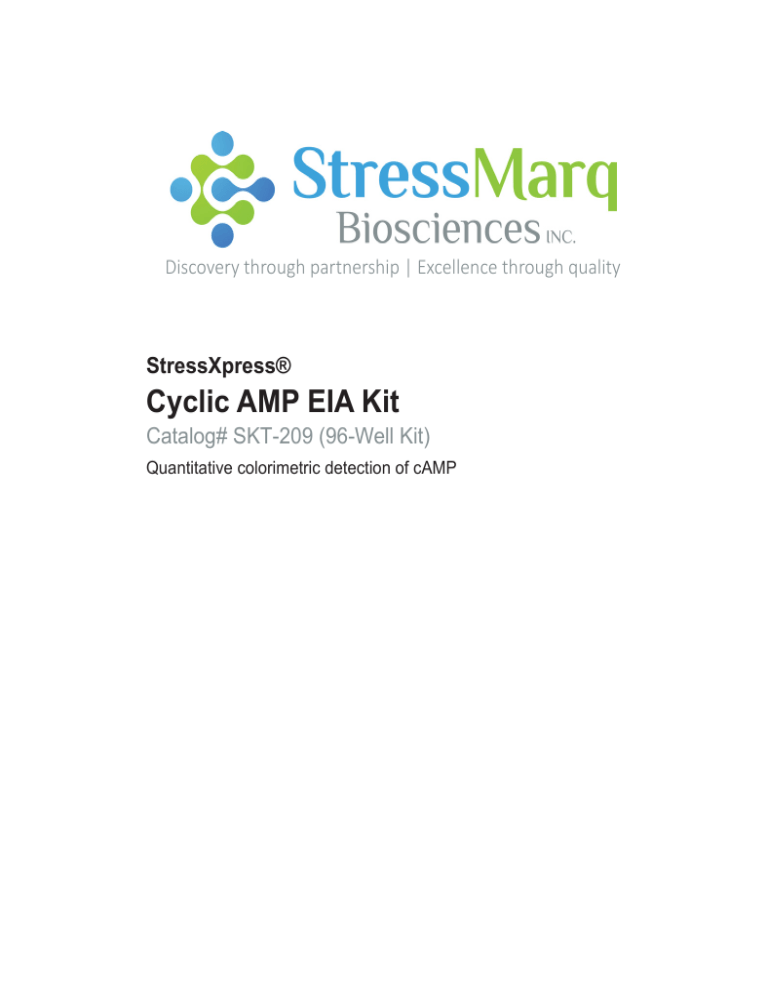
Discovery through partnership | Excellence through quality
StressXpress®
Cyclic AMP EIA Kit
Quantitative colorimetric detection of cAMP
Catalog# SKT-209 (96-Well Kit)
TABLE OF CONTENTS
GENERAL INFORMATION
4 Materials Supplied
5Precautions
5Storage
6 Materials Needed but Not Supplied
INTRODUCTION
7Background
8 Assay Overview
PRE-ASSAY PREPARATION
9
10
12
12
13
14
14
15
ASSAY PROTOCOL
18 Assay Protocol - Regular Format
19 Assay Protocol - Acetylated Format
ANALYSIS
RESOURCES
21
21
25
25
28
28
28
28
Sample Types
Sample Preparation
Reagent Preparation
Reagent Preparation - Regular Format
Standard Preparation - Regular Format
Acetylated Protocol - Overview
Reagent Preparation - Acetylated Format
Standard Preparation - Acetylated
Calculation of Results
Typical Data - Regular Format
Validation Data - Regular Format
Typical Data - Acetylated Format
Validation Data - Acetylated Format
Validation Data - Regular and Acetylated
Sample Values
Cross Reactivity and Interferents
29References
30 Warranty and Limitation of Remedy
31 Plate Template
32Notes
GENERAL INFORMATION
Materials Supplied
Catalog
Number
Reagent
Quantity
Description
SKC-209A
Coated Clear 96 Well
Plates
1 Each
A clear plastic microtiter plate coated
with donkey anti-sheep IgG.
SKC-209B
Cyclic AMP Standard
125 µL
Cyclic AMP at 1,500 pmol/mL in a
special stabilizing solution.
SKC-209C
StressXpress® Cyclic
AMP Antibody
3 mL
A sheep antibody specific for cyclic
AMP.
SKC-209D
StressXpress® Cyclic
AMP Conjugate
3 mL
A cyclic AMP-peroxidase conjugate in a
special stabilizing solution.
SKC-209E
Sample Diluent
28 mL
Contains special stabilizers and
additives. Ready-to-use Sample Diluent.
CAUSTIC
SKC-209F
Plate Primer
5 mL
A neutralizing solution containing
special stabilizers and additivies.
SKC-209G
Acetic Anhydride
2mL
WARNING: Corrosive Lachrymator
SKC-209H
Triethylamine
4mL
WARNING: Corrosive Lachrymator
SKC-209I
Wash Buffer
Concentrate
30 mL
A 20X concentrate that must be diluted
with deionized or distilled water.
SKC-209J
TMB Substrate
11mL
-
SKC-209K
Stop Solution
5 mL
A 1M solution of hydrochloric acid.
CAUSTIC.
SKC-209L
Plate Sealer
1 Each
-
If any of the items listed above are damaged or missing, please contact our Customer
Service department at (250) 294-9065. We cannot accept any returns without prior
authorization.
!
4
WARNING: Not for human or animal disease diagnosis or therapeutic drug
use.
GENERAL INFORMATION
Precautions
As with all such products, this kit should only be used by qualified personnel who
have had laboratory safety instruction. The complete booklet should be read and
understood before attempting to use the product.
This kit utilizes a peroxidase-based readout system. Buffers, including other
manufacturers Wash Buffers, containing sodium azide will inhibit color production
from the enzyme. Make sure all buffers used for samples are azide free. Ensure
that any plate washing system is rinsed well with deionized water prior to using the
supplied Wash Buffer as prepared on Page 10.
The antibody coated plate needs to be stored desiccated. The silica gel pack
included in the foil ziploc bag will keep the plate dry. The silica gel pack will turn
from blue to pink if the ziploc has not been closed properly.
The supplied Sample Diluent and Sample Diluent Concentrate are acidic. The
Stop Solution is 1M HCl. These solutions should not come in contact with skin
or eyes. Take appropriate precautions when handling these reagents.
The kit uses acetic anhydride and triethylamine as acetylation reagents.
Triethylamine and acetic anhydride are lachrymators.
Caution - corrosive, flammable, and harmful vapor. Use in hood with proper
ventilation and wear appropriate protective safety wear.
Storage
All components of this kit should be stored at 4°C until the expiration date of the kit.
GENERAL INFORMATION
5
Materials Needed But Not Supplied
• Distilled or deionized water.
• Repeater pipet with disposable tips capable of dispensing 25 µL, 50 µL and
100 µL.
• A microplate shaker.
• Colorimetric 96 well microplate reader capable of reading optical density
at 450 nm.
• Software for converting raw relative optical density readings from the
plate reader and carrying out four parameter logistic curve (4PLC) fitting.
Contact your plate reader manufacturer for details.
Please read this booklet completely prior to using the product.
FOR RESEARCH USE ONLY.
NOT FOR USE IN DIAGNOSTIC PROCEDURES.
6
GENERAL INFORMATION
INTRODUCTION
Background
Adenosine-3’,5’-cyclic monophosphate, or cyclic AMP (cAMP), C10H12N5O6P,
is one of the most important second messengers and a key intracellular regulator.
Discovered by Sutherland and Rall in 1957 (1), it functions as a mediator of
activity for a number of hormones, including epinephrine, glucagon, and ACT
(2-4). Adenylate cyclase is activated by the hormones glucagon and adrenaline
and by G protein. Liver adenylate cyclase responds more strongly to glucagon,
and muscle adenylate cyclase responds more strongly to adrenaline. cAMP
decomposition into AMP is catalyzed by the enzyme phosphodiesterase. In
the Human Metabolome Database there are 166 metabolic enzymes listed that
convert cAMP (5).
Other biological actions of cAMP include regulation of innate immune functioning
(6), axon regeneration (7), cancer (8), and inflammation (9).
INTRODUCTION
7
Assay Overview
The Cyclic AMP StressXpress® Direct EIA kit is designed to quantitatively measure
cAMP present in lysed cells, EDTA and heparin plasma, urine, saliva and tissue
culture media samples. Please read the complete kit booklet before performing
this assay.
For tissue samples, saliva and urine, where the levels of cAMP are expected to be
relatively high, the regular format for the assay can be used. For plasma samples
and some dilute cell lysates an optional acetylation protocol can be used.
The kit is unique in that all samples and standards are diluted into an acidic Sample
Diluent, which contains special additives and stabilizers, for cAMP measurement.
This allows plasma, urine and saliva samples to be read in an identical manner to lysed
cells. Acidified samples of cAMP are stable and endogenous phosphodiesterases
are inactivated in the Sample Diluent. A cAMP standard is provided to generate a
standard curve for the assay and all samples should be read off the standard curve.
A clear microtiter plate coated with an antibody to capture sheep IgG is provided
and a neutralizing Plate Primer solution is added to all the used wells. Standards
or diluted samples, either with or without acetylation, are pipetted into the primed
wells. A cAMP-peroxidase conjugate is added to the standards and samples in the
wells. The binding reaction is initiated by the addition of a sheep antibody to
cAMP to each well. After a 2 hour incubation, the plate is washed and substrate
is added. The substrate reacts with the bound cAMP-peroxidase conjugate. After
a short incubation, the reaction is stopped and the intensity of the generated color
is detected in a microtiter plate reader capable of measuring 450 nm wavelength.
The concentration of the cAMP in the sample is calculated, after making suitable
correction for the dilution of the sample, using software available with most plate
readers.
8
INTRODUCTION
PRE-ASSAY PREPARATION
Sample Types
Sample Types Validated:
Cell Lysates, Saliva, Urine, EDTA and Heparin Plasma, Tissue Culture Media
This assay has been validated for lysed cells, saliva, urine, EDTA and heparin plasma
samples and for tissue culture media samples. Samples should be stored at -70°C for
long term storage. 24-Hour urine samples may need to have 1 mL concentrated
hydrochloric acid added for every 100 mL volume to act as a preservative. Samples
containing visible particulate should be centrifuged prior to using.
Cyclic AMP is identical across all species and we expect this kit may measure cAMP
from sources other than human. The end user should evaluate recoveries of cAMP in
other samples being tested.
After dilution in the Sample Diluent (see page 11) there may be some precipitation
of proteins and the supernatant from the centrifuged samples used. After being
diluted in Sample Diluent the samples can be assayed directly within 2 hours, or
frozen at ≤ -70°C for later analysis. Severely hemolyzed samples should not be
used in this kit.
For samples containing low levels of cAMP and for all plasma samples, the
acetylated assay protocol must be used due to its enhanced sensitivity. All
standards and samples should be diluted in glass test tubes.
PRE-ASSAY PREPARATION
9
Sample Preparation
Cells
Cell lysis buffers containing high concentrations of SDS or other detergents
may not be compatible with this assay or may require extra dilution. Please read
Interferents section on page 27 for more information.
This kit is compatible with either adherent or non-adherent cells. The cells can
be grown in any suitable sterile containers such as Petri dishes, 12-, 48- or 96-well
culture plates or flasks. The cells must be isolated from the media prior to being
lysed with the provided Sample Diluent. The acidic Sample Diluent contains
detergents to lyse the cells, inactivate endogenous phosphodiesterases and stabilize
the cAMP. Some cell types are extremely hardy and the end user should optimize
the lysis conditions utilizing freeze-thaw cycles and ultrasonic treatments to fully
lyse their cells.
We used ~ 107 Jurkat cells per mL of Sample Diluent. Cell number needs to be
determined by the end user since it will be dependant on cell type and treatment
conditions. Care must be taken not to over dilute the samples.
For adherent cells, the media should be aspirated from the cells and the cells washed
with PBS. The adherent cells should be treated directly with the Sample Diluent
for 10 minutes at room temperature. Cells can be scraped to dislodge them from
the plate surface and cells should be inspected to ensure lysis. Detergent has been
added to the Sample Diluent to help lysis occur. Centrifuge the samples at ≥600 x
g at 4°C for 15 minutes and assay the supernatant directly. If required, the TCM
can be assayed for cAMP as outlined below.
For non-adherent cells, pellet and wash the cells with PBS by centrifuging
the samples at ≥600 x g at 4°C for 15 minutes as described above. Treat the
aspirated, washed pellet directly with the Sample Diluent for 10 minutes at room
temperature. Cells should be inspected to ensure lysis. Detergent has been added
to the Sample Diluent to help lysis occur. Centrifuge the samples at ≥600 x g at 4
°C for 15 minutes and assay the supernatant directly. If required, the TCM can be
assayed for cAMP as outlined below.
PRE-ASSAY PREPARATION
10
Tissue Samples
Tissues samples should be frozen in liquid nitrogen and stored at -80°C if analysis is not
to be carried out immediately.
Grind the frozen tissue in a stainless steel mortar under liquid nitrogen until it is a fine
powder. Allow the liquid nitrogen to evaporate and weigh the powdered tissue. Add 1
mL of Sample Diluent for every 100 mg of tissue. Incubate in the Sample Diluent for 10
minutes on ice, and then centrifuge at ≥600 x g at 4°C for 15 minutes. Collect the
supernatant and run in the assay immediately or store frozen at ≤ -70°C.
For samples that require concentration and delipidation, a trichloroacetic acid (TCA)/
ether protocol can be used. Grind the frozen tissue in a stainless steel mortar under liquid
nitrogen until it is a fine powder. Allow the liquid nitrogen to evaporate and weigh the
powdered tissue. Add 1 mL of ice cold 5% TCA (weight/volume) for every 100 mg of
tissue and grind in a glass-Teflon mortar. Incubate in the TCA for 10 minutes on ice, and
then centrifuge at ≥600 x g at 4°C for 15 minutes. Collect the supernatant.
For every 1 mL of TCA supernatant add 3 mL of water saturated diethyl ether*
and shake in a glass vial. Allow the ether to separate as the top layer, remove it
and discard the ether. Dry the aqueous layer by lyophilization or using a vacuum
centrifuge. Reconstitute by adding 1 mL of Sample Diluent for every mL of 5%
TCA used to extract and run in the assay immediately or store at ≤ -70°C.
*Diethyl ether is extremely flammable and should be used in a hood.
Tissue Culture Media
For measuring cAMP in tissue culture media (TCM), samples should be read off
a standard curve generated in TCM. Samples may need to be diluted further in
TCM. We have validated the assay using RPMI-1640.
Plasma Samples
Plasma samples should be diluted ≥ 1:10 with the supplied Sample Diluent and acetylated
prior to running in the Acetylated Format assay (page 18).
PRE-ASSAY PREPARATION
11
Urine Samples
Urine samples should be diluted ≥ 1:20 with the supplied Sample Diluent prior
running in the assay. Due to the high concentration of cAMP in urine, samples
may need to be diluted further.
Saliva Samples
Saliva samples should be diluted ≥ 1:4 with the supplied Sample Diluent prior
running in the assay. See our Saliva Sample Handling Instructions available on this
product’s website page.
Use all samples within 2 hours of dilution in Sample Diluent.
Reagent Preparation
Allow the kit reagents to thaw and come to room temperature for 30-60 minutes.
We recommend that all standards and samples be run in duplicate to allow the end
user to accurately determine cAMP concentrations. Ensure that all samples have
reached room temperature and have been diluted as appropriate prior to running
them in the kit.
Wash Buffer
Dilute Wash Buffer Concentrate 1:20 by adding one part of the concentrate to
nineteen parts of deionized water. Once diluted this is stable at room temperature
for 3 months.
Sample Diluent
Do not dilute the Sample Diluent (Catalog Number SKC-209E)
Reagent Preparation - Regular Format
Use this format for urine, saliva and some cell lysates. Do NOT use for plasma
samples.
All standards and samples should be diluted in glass test tubes.
12
PRE-ASSAY PREPARATION
Standard Preparation - Regular Format
Label six test tubes as #1 through #6. Pipet 270 µL of Sample Diluent into tube
#1 and 200 µL into tubes #2 to #6. The Cyclic AMP stock solution contains an
organic solvent. Prerinse the pipet tip several times to ensure accurate delivery.
Carefully add 30 µL of the cAMP stock solution to tube #1 and vortex completely.
Take 100 µL of the cAMP solution in tube #1 and add it to tube #2 and vortex
completely. Repeat the serial dilutions for tubes #3 through #6. The concentration
of Cyclic AMP in tubes 1 through 6 will be 150, 50, 16.67, 5.56, 1.85, and 0.617
pmol/mL.
Non-Acetylated
Standard
1
Standard
2
Standard
3
Standard
4
Standard
5
Standard
6
Sample Diluent
(µL)
270
200
200
200
200
200
Addition
Stock
Standard
1
Standard
2
Standard
3
Standard
4
Standard
5
Volume of
Addition (µL)
30
100
100
100
100
100
Final
Concentration
(pM/mL)
150
50
16.67
5.56
1.85
0.617
Use Standards within 1 hour of preparation.
PRE-ASSAY PREPARATION
13
Acetylated Protocol - Overview
Use this format for plasma, some cell lysates and any sample with low cAMP
concentrations.
Prior to running the acetylated assay, all standards, samples and the Sample Diluent
used for the B0 and NSB wells must be acetylated. Acetylation is carried out by
adding 10 µL of the Acetylation Reagent (as prepared below) for each 200 µL of
the standard, sample and Sample Diluent. Vortex each treated standard, sample
or Sample Diluent after addition of the Acetylation Reagent and use within 30
minutes of preparation.
Note: Upon Acetylation, all of the standards and samples diluted in the orange
Sample Diluent will change to a pale yellow colour.
Reagent Preparation - Acetylated Format
Acetylation Reagent
Working in a fume hood mix one part of Acetic Anhydride with 2 parts of
Triethylamine in a glass test tube. Use the following table to help determine the
amount of Acetylation Reagent to make.
Reagents
Number of Samples to be Tested
20
40
100
200
Acetic Anhydride Volume (µL)
200
400
1,000
2,000
Triethylamine Volume (µL)
400
800
2,000
4,000
Acetylation Reagent Volume (mL)
0.6
1.2
3
6
Use the Acetylation Reagent within 60 minutes of preparation.
14
PRE-ASSAY PREPARATION
Standard Preparation - Acetylated
All standards and samples should be diluted in glass test tubes.
Label seven test tubes as #1 through #7. Label one tube as Stock Dilution. Pipet
270 µL of Sample Diluent into the Stock Dilution tube. Pipet 560 µL of Sample
Diluent into tube #1 and 300 µL into tubes #2 to #6. The Cyclic AMP stock
solution contains an organic solvent. Prerinse the pipet tip several times to ensure
accurate delivery. Carefully add 30 µL of the cAMP stock solution to the Stock
Dilution tube and vortex completely. Carefully add 40 µL of the Stock Dilution
tube to tube #1 and vortex completely. Take 300 µL of the cAMP solution in tube
#1 and add it to tube #2 and vortex completely. Repeat the serial dilutions for
tubes #3 through #7. The concentration of Cyclic AMP in tubes 1 through 7 will
be 10, 5, 2.5, 1.25, 0.625, 0.313 and 0.156 pmol/mL.
PRE-ASSAY PREPARATION
15
16
PRE-ASSAY PREPARATION
270
Stock
30
150
Sample
Diluent (µL)
Addition
Volume of
Addition (µL)
Final
Concentration
(pmol/mL)
Stock
Dilution
10
5
300
Standard
1
Stock
Dilution
40
300
Standard
2
560
Standard
1
2.5
300
Standard
2
300
Standard
3
1.25
300
Standard
3
300
Standard
4
0.625
300
Standard
4
300
Standard
5
0.313
300
Standard
5
300
Standard
6
0.156
300
Standard
6
300
Standard
7
Standard and Sample Acetylation
Pipet 300 µL of Sample Diluent into a glass tube to act as the Zero standard/
NSB tube. Add 15 µL of Acetylation Reagent to this tube and vortex immediately.
Proceed to assay within 30 minutes.
Pipet 200 µL of each standard or sample to be tested into glass tubes. Add 10 µL
of the Acetylation Reagent into each tube and vortex immediately. Proceed to assay
within 30 minutes.
NOTE: Samples and Sample Diluent will turn from orange to pale yellow upon
acetylation.
Use Acetylated Standards and Samples within 30 minutes of preparation.
PRE-ASSAY PREPARATION
17
ASSAY PROTOCOL
Assay Protocol - Regular Format
1. Use the plate layout sheet on page 30 to aid in proper sample and standard
identification. Determine the number of wells to be used and return unused
wells to the foil pouch with desiccant. Seal the ziploc plate bag and store at
4˚C.
2. Add 25 µL of Plate Primer into all wells used. Failure To Add Plate Primer
To ALL Wells First Will Cause Assay To Fail.
3. Pipet 75 µL Sample Diluent into the non-specific binding (NSB) wells.
4. Pipet 50 µL of Sample Diluent into wells to act as maximum binding wells
(Bo or 0 pg/mL).
5. Pipet 50 µL of samples or standards into wells in the plate.
6. NOTE: Sample Diluent will turn from orange to bright pink upon sample
or standard addition to the Plate Primer in the wells.
7. Add 25 µL of the StressXpress® cAMP Conjugate to each well using a repeater
pipet.
8. Add 25 µL of the StressXpress® cAMP Antibody to each well, except the NSB
wells, using a repeater pipet.
9. Gently tap the sides of the plate to ensure adequate mixing of the reagents.
Cover the plate with the plate sealer and shake at room temperature for 2
hours. If the plate is not shaken, signals bound will be approximately 25%
lower.
10.Aspirate the plate and wash each well 4 times with 300 µL wash buffer. Tap
the plate dry on clean absorbent towels.
18
ASSAY PROTOCOL
11.Add 100 µL of the TMB Substrate to each well, using a repeater.
12.Incubate the plate at room temperature for 30 minutes without shaking.
13.Add 50 µL of the Stop Solution to each well, using a repeater pipet.
14.Read the optical density generated from each well in a plate reader capable
of reading at 450 nm.
15.Use the plate reader’s built-in 4PLC software capabilities to calculate cAMP
concentration for each sample.
Assay Protocol - Acetylated Format
1. Use the plate layout sheet on page 30 to aid in proper sample and standard
identification. Determine the number of wells to be used and return unused
wells to the foil pouch with desiccant. Seal the ziploc plate bag and store at
4˚C.
2. Add 50 µL of Plate Primer into all wells used. Failure To Add Plate Primer
To ALL Wells First Will Cause Assay To Fail.
3. Pipet 75 µL acetylated Sample Diluent into the non-specific binding (NSB)
wells.
4. Pipet 50 µL of acetylated Sample Diluent into wells to act as maximum binding
wells (Bo or 0 pg/mL).
5. Pipet 50 µL of acetylated samples or standards into wells in the plate.
6. Add 25 µL of the StressXpress® cAMP Conjugate to each well using a repeater
pipet.
7. Add 25 µL of the StressXpress® cAMP Antibody to each well, except the NSB
wells, using a repeater pipet.
8. Gently tap the sides of the plate to ensure adequate mixing of the reagents.
ASSAY PROTOCOL
19
Cover the plate with the plate sealer and shake at room temperature for 2
hours. If the plate is not shaken, signals bound will be approximately 25%
lower.
9. Note: Wells will have turned from very pale yellow to pale pink during
incubation.
10.Aspirate the plate and wash each well 4 times with 300 µL wash buffer. Tap the
plate dry on clean absorbent towels.
11.Add 100 µL of the TMB Substrate to each well, using a repeater pipet.
12.Incubate the plate at room temperature for 30 minutes without shaking.
13.Add 50 µL of the Stop Solution to each well, using a repeater pipet.
14.Read the optical density generated from each well in a plate reader capable of
reading at 450 nm.
15.Use the plate reader’s built-in 4PLC software capabilities to calculate cAMP
concentration for each sample.
20
ASSAY PROTOCOL
ANALYSIS
Calculation of Results
Average the duplicate OD readings for each standard and sample. Create a
standard curve by reducing the data using the 4PLC fitting routine on the plate
reader, after subtracting the mean OD’s for the NSB. The sample concentrations
obtained, calculated from the %B/B0 curve, should be multiplied by the dilution
factor to obtain neat sample values.
Typical Data - Regular Format
Sample
Mean OD
Net OD
% B/B0
Cyclic AMP Concentration (pmol/
mL)
NSB
0.054
0
-
-
Standard 1
0.155
0.101
10.6
150
Standard 2
0.257
0.203
21.3
50
Standard 3
0.411
0.357
37.4
16.67
Standard 4
0.637
0.583
61.1
5.56
Standard 5
0.873
0.819
85.8
1.85
Standard 6
0.973
0.919
96.3
0.617
B0
1.008
0.954
100.0
0
Sample 1
0.510
0.456
47.8
10.4
Sample 2
0.634
0.580
60.7
6.0
Always run your own standard curve for calculation of results.
Do not use this data.
ANALYSIS
21
22
ANALYSIS
0.1
1
10
100
%B/B0
Net OD
0.2
0.1
0.0
1000
20%
10%
0%
Cyclic AMP Conc. (pmol/mL)
0.3
0.4
0.5
30%
40%
%B/B0
50%
0.6
60%
0.8
80%
0.7
0.9
90%
70%
1.0
100%
Net OD
Typical Standard Curve - Regular Format
Validation Data - Regular Format
Sensitivity and Limit of Detection
Sensitivity was calculated by comparing the OD’s for nineteen wells run for each of
the B0 and standard #6. The detection limit was determined at two (2) standard
deviations from the B0 along the standard curve.
Sensitivity was determined as 0.64 pmol/mL.
The Limit of Detection for the assay was determined in a similar manner by
comparing the OD’s for twenty runs for each of the zero standard and a low
concentration human urine sample.
Limit of Detection was determined as 0.20 pmol/mL
Typical Data - Acetylated
Sample
Mean OD
Net OD
% B/B0
Cyclic AMP Concentration
(pmol/mL)
NSB
0.045
0
-
-
Standard 1
0.107
0.062
12.5
10
Standard 2
0.140
0.095
19.1
5
Standard 3
0.192
0.147
29.6
2.5
Standard 4
0.282
0.237
47.7
1.25
Standard 5
0.367
0.322
64.8
0.625
Standard 6
0.434
0.389
78.3
0.3125
Standard 7
0.474
0.429
86.3
0.156
B0
0.542
0.497
100.0
0
Sample 1
0.231
0.186
37.4
1.820
Sample 2
0.369
0.324
65.2
0.622
Always run your own standard curve for calculation of results.
Do not use this data.
ANALYSIS
23
24
ANALYSIS
0%
10%
20%
30%
40%
%B/B0
50%
60%
70%
80%
90%
100%
0.1
Cyclic AMP Conc. (pmol/mL)
1
%B/B0
Net OD
10
0.0
0.1
0.2
0.3
0.4
0.5
Net OD
Typical Standard Curve - Acetylated
Validation Data - Acetylated Format
Sensitivity and Limit of Detection - Acetylated
Sensitivity was calculated by comparing the OD’s for nineteen wells run for each
of the acetylated B0 and standard #6. The detection limit was determined at two
(2) standard deviations from the B0 along the standard curve.
Sensitivity was determined as 0.083 pmol/mL.
The Limit of Detection for the assay was determined in a similar manner by
comparing the OD’s for twenty runs for each of acetylated zero standard and a low
concentration acetylated human sample.
Limit of Detection was determined as 0.078 pmol/mL. This is equivalent to 3.9
fmol cAMP per sample.
Validation Data - Regular and Acetylated
Linearity
Linearity was determined by taking two human urine samples, one with a low
cAMP level of 10.7 pmol/mL and one with a higher level of 91.5 pmol/mL,
and mixing them in the ratios given below. The measured concentrations were
compared to the expected values based on the ratios used.
High Serum
Low Serum
Observed
Concentration
(pmol/mL)
Expected Concentration
(pmol/mL)
% Recovery
80%
20%
63.6
75.4
84.4
60%
40%
47.4
59.2
80.1
40%
60%
41.7
43.0
97.0
20%
80%
30.9
26.9
114.9
Mean Recovery
94.1%
ANALYSIS
25
Intra Assay Precision - Regular
Three human urine samples were diluted with Sample Diluent and run in replicates
of 20 in an assay. The mean and precision of the calculated cAMP concentrations
were:
Sample
Cyclic AMP Concentration (pmol/mL)
%CV
1
56.9
8.6
2
11.9
11.3
3
6.7
12.3
Inter Assay Precision - Regular
Three human urine samples were diluted with Sample Diluent and run in duplicates
in twelve assays run over multiple days by four operators. The mean and precision
of the calculated cAMP concentrations were:
26
Sample
Cyclic AMP Concentration (pmol/mL)
%CV
1
57.1
10.0
2
10.9
11.5
3
6.3
11.3
ANALYSIS
Intra Assay Precision - Acetylated
Two human plasma samples were diluted with Sample Diluent, acetylated and run
in replicates of 20 in an assay. The mean and precision of the calculated cAMP
concentrations were:
Sample
Cyclic AMP Concentration (pmol/mL)
%CV
1
1.74
10.4
2
0.60
11.8
Inter Assay Precision - Acetylated
One human urine and two human plasma sample were diluted with Sample
Diluent, acetylated and run in duplicates in twelve assays run over multiple days
by four operators. The mean and precision of the calculated cAMP concentrations
were:
Sample
Cyclic AMP Concentration (pmol/mL)
%CV
1
5.22
9.8
2
I.99
8.1
3
0.73
15.4
ANALYSIS
27
Sample Values
Seven human plasma samples were tested in the assay. Diluted samples were
acetylated and run in the Acetylated Format. Values ranged from 9.0 to
16.27 pmol/mL with an average for the samples of 13.1 pmol/mL. The normal
reference range for cAMP in plasma is 3.9-13.7 pmol/mL (10). Seven normal
human urine samples were diluted > 1:30 in Sample Diluent and values ranged in
the neat samples from 2,879 to 4,692 pmol/mL with an average for the samples of
3,690.1 pmol/mL. The normal reference range for cAMP in urine is 800-12,000
pmol/mL (11). Six normal human saliva samples were diluted 1:4 in Sample
Diluent and run in both the Regular and Acetylated Formats. Values ranged from
4.91 to 15.07 pmol/mL with an average of 8.54 pmol/mL in the neat samples.
The normal range for cAMP in saliva is 3.4-17.2 pmol/mL (12).
Cross Reactivity
The following cross reactants were tested in the assay and calculated at the 50%
binding point.
Nucleotide
Cross Reactivity (%)
Cyclic AMP
100%
AMP
< 0.08%
GMP
< 0.08%
Cyclic GMP
< 0.08%
ATP
< 0.08%
Interferents
A variety of detergents were tested as possible interfering substances in the assay.
CHAPS, and Tween 20 at 0.1% increased measured cAMP by 8.9 and decreased
measured cAMP by 0.9% respectively. Triton X-100 at 2% increased measured
cAMP by 1.8% and CTAC at 0.05% increased measured cAMP by 6.3%. Samples
containing SDS above 0.01% should not be used in the assay.
28
ANALYSIS
RESOURCES
References
1. Sutherland, E. W. and Rall, T. W. Fractionation and Characterization of a Cyclic
Adenine Ribonucleotide Formed by Tissue Particles. J. Biol. Chem., 232:1077, 1958.
2. Marsh, J.M., The Role of Cyclic AMP in Gonadal Steroidogenesis. Biol. Reprod.,
14:30-53, 1976.
3. Korenman, S.G. and Krall, J.F., The Role of Cyclic AMP in the Regulation of Smooth
Muscle
Cell Contraction in the Uterus. Biol. Reprod., 16:1-17, 1977.
4. Kelley, D.J., Bhattacharyya, A., Lahvis, G.P., Yin, J.C.P., Malter, J., and Davidson,
R.J., The Cyclic AMP Phenotype of Fragile X and Autism. Neurosci. Biobehav. Rev.,
32(8): 1533-1543, 2008.
5. http://www.hmdb.ca/metabolites/HMDB00058
6. Serezani, C.H., Ballinger, M.N., Aronoff, D.M., and Peters-Golden, M., Cyclic
AMP. Master Regulator of Innate Immune Cell Function. Am. J. Resp. Cell and
Mol. Biol., 39 (2): 127, 2008.
7. Hannila, S.S., and Filbin, M.T., The role of cyclic AMP signaling in promoting
axonal regeneration after spinal cord injury. Exp. Neurol., 209(2): 321–332, 2008.
8. Shankar, D.B, Cheng, J.C., and Sakamoto, K.M., Role of cyclic AMP response
element binding protein in human leukemias. Cancer, 104(9):1819-24, 2005.
9. Galea E. and Feinstein, D.L., Regulation of the expression of the inflammatory nitric
oxide synthase (NOS2) by cyclic AMP. FASEB J., 13:2095-2137, 1999.
10.NIH Clinical Center, http://cclnprod.cc.nih.gov/dlm/testguide.nsf/Index/EB6E90F
8D951346F85256BA4004C96E4?OpenDocument
11.NIH Clinical Center, http://cclnprod.cc.nih.gov/dlm/testguide.nsf/Index/24B381A
EE513EB8785256BA40052ADAD?OpenDocument
12.Sproles, A.C., Cyclic AMP Concentration in Saliva of Normal Children and Children
with Down’s Syndrome, J. Dent. Res., 1976, 52, 915-917.
RESOURCES
29
Warranty and Limitation of Remedy
StressMarq Biosciences Inc. makes no warranty or guarantee of any kind, whether
written or oral, expressed or implied, including without limitation, any warranty of
fitness for a particular purpose, suitability and merchantability, which extends beyond the
description of the chemicals hereof. StressMarq warrants only to the original customer
that the material will meet our specifications at the time of delivery. StressMarq will carry
out its delivery obligations with due care and skill. Thus, in no event will StressMarq have
any obligation or liability, whether in tort (including negligence) or in contract, for
any direct, indirect, incidental or consequential damages, even if StressMarq is informed
about their possible existence. This limitation of liability does not apply in the case of
intentional acts or negligence of StressMarq, its directors or its employees.
Buyer’s exclusive remedy and StressMarq’s sole liability hereunder shall be limited to
a refund of the purchase price, or at StressMarq’s option, the replacement, at no cost to
Buyer, of all material that does not meet our specifications.
Said refund or replacement is conditioned on Buyer giving written notice to StressMarq
within thirty (30) days after arrival of the material at its destination. Failure of Buyer to
give said notice within thirty (30) days shall constitute a waiver by Buyer of all claims
hereunder with respect to said material.
For further details, please refer to our Warranty and Refund Policy located on our
website and in our catalog.
Contact Information
Phone:250-294-9065
Fax:
250-294-9025
E-Mail:techsupport@stressmarq.com
Hours:
M-F 9:00 AM to 5:00 PM PST
In order for our staff to assist you quickly and efficiently, please be ready to supply the lot
number of the kit (found on the outside of the box).
30
RESOURCES
RESOURCES
31
H
G
F
E
D
C
B
A
1 2 3 4 5 6 7 8 9 10 11 12
NOTES
This document is copyrighted. All rights are reserved. This document may not, in whole or
part, be copied, photocopied, reproduced, translated, or reduced to any electronic medium
or machine-readable form without prior consent, in writing, from StressMarq Biosciences
Inc. ©08/28/2010, StressMarq Biosciences Inc., Victoria, BC Canada, All rights reserved.
Printed in Canada.
32
RESOURCES

